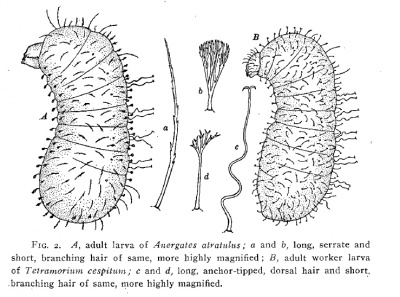Tetramorium atratulum
| Tetramorium atratulum | |
|---|---|

| |
| Conservation status | |
| Scientific classification | |
| Kingdom: | Animalia |
| Phylum: | Arthropoda |
| Class: | Insecta |
| Order: | Hymenoptera |
| Family: | Formicidae |
| Subfamily: | Myrmicinae |
| Tribe: | Crematogastrini |
| Genus: | Tetramorium |
| Species: | T. atratulum |
| Binomial name | |
| Tetramorium atratulum (Schenck, 1852) | |
| Synonyms | |
| |
This species (previously and sometimes still known as Anergates atratulus) is a rarely encountered workerless inquiline of Tetramorium caespitum, Tetramorium impurum, Tetramorium diomedeum, as well as Tetramorium moravicum in Bulgaria (Lapeva-Gjonova et al., 2012) and Tetramorium chefketi in Bulgaria and Turkey (Lapeva-Gjonova et al., 2012); there is also a single record with Tetramorium immigrans (Wagner et al., 2017; Seifert, 2018) (see also Buschinger, 1995; de la Mora et al., 2021; Sanetra et al., 1994; Sanetra et al., 1999; Sanetra & Buschinger, 2000; Seifert, 2018; Wagner et al., 2017).
| At a Glance | • Workerless Inquiline • Secretly invasive |
Photo Gallery
 Tetramorium atratulum dealate gyne moving freely in Tetramorium caespitum nest associated with the social parasite Strongylognathus testaceus (photo: A. Purkart, from Purkart et al., 2022, Fig. 8).
Tetramorium atratulum dealate gyne moving freely in Tetramorium caespitum nest associated with the social parasite Strongylognathus testaceus (photo: A. Purkart, from Purkart et al., 2022, Fig. 8). I: The development stages of Tetramorium cf. caespitum brood: a worker larva, b worker mature larva, c worker pre-pupa, d alate mature larva; II: The development stages of Tetramorium atratulum brood: a alate mature larva, b alate pre-pupa, c gyne pupa dorsal view, d gyne pupa ventral view. All specimens were collected on 22th April 2019 at one sampling plot (photos: D. Selnekovič, from Purkart et al., 2022, Fig. 2).
I: The development stages of Tetramorium cf. caespitum brood: a worker larva, b worker mature larva, c worker pre-pupa, d alate mature larva; II: The development stages of Tetramorium atratulum brood: a alate mature larva, b alate pre-pupa, c gyne pupa dorsal view, d gyne pupa ventral view. All specimens were collected on 22th April 2019 at one sampling plot (photos: D. Selnekovič, from Purkart et al., 2022, Fig. 2).
Identification
From Fisher and Cover (2007): The males are found only in nests of the host and are pupoidal - cream to yellow in color, wingless, and barely able to walk. The queens are tiny and physogastric when found in the host nest. When found outside the nest they are dispersing and may be recognized by the unique, prominent median longitudinal depression on the dorsal surface of the gaster.
Keys including this Species
Distribution
Spain to Central Siberia, North Italy to South Sweden, also North America (primarily the Northeast, with a single record from Colorado (Collingwood, 1979; Dash & Sanchez, 2009).
Latitudinal Distribution Pattern
Latitudinal Range: 59.08391° to 37.118611°.
| North Temperate |
North Subtropical |
Tropical | South Subtropical |
South Temperate |
- Source: AntMaps
Distribution based on Regional Taxon Lists
Nearctic Region: United States.
Palaearctic Region: Albania, Armenia, Austria, Belarus, Belgium, Bulgaria, Channel Islands, Croatia, Czechia, Denmark, Finland, France, Germany (type locality), Greece, Hungary, Iberian Peninsula, Italy, Latvia, Lithuania, Luxembourg, Netherlands, Norway, Poland, Republic of Moldova, Romania, Russian Federation, Slovakia, Spain, Sweden, Switzerland, Türkiye, Ukraine, United Kingdom of Great Britain and Northern Ireland.
Distribution based on AntMaps
Distribution based on AntWeb specimens
Check data from AntWeb
Countries Occupied
| Number of countries occupied by this species based on AntWiki Regional Taxon Lists. In general, fewer countries occupied indicates a narrower range, while more countries indicates a more widespread species. |
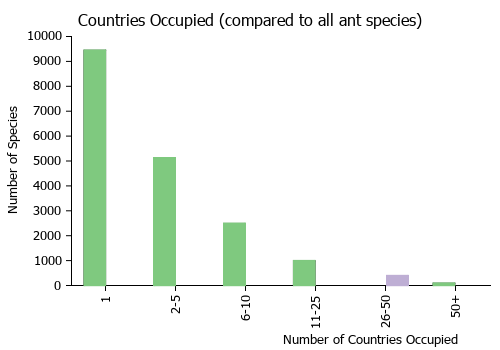
|
Estimated Abundance
| Relative abundance based on number of AntMaps records per species (this species within the purple bar). Fewer records (to the left) indicates a less abundant/encountered species while more records (to the right) indicates more abundant/encountered species. |

|
Biology
Queens are most likely adopted in orphaned host colonies (Fisher and Cover 2007, Buschinger 2009). Queens and males mate in the nest. Sex ratios are female biased (Heinze and Buschinger 2007)
A. Buschinger was able to rear a parasitized colony that successfully produced sexuals, as reported here: [1]
Wheeler (1908) described atratulum queens and males he found in nest during a 1907 visit to Europe. Not only does his account provide insights about this ant's biology, it is also an interesting account of Wheeler collecting, and experimenting with, ants with Forel.
"On only one occasion was I fortunate enough to find a colony of this rare, workerless parasite. June 6, at 2 P. M., while collecting near Vaud, in the very meadow in which Forel as a young man made many of his classical' observations for the "Fourmis de la Suisse", I discovered a medium-sized Tetramorium caespitum colony from which female atratulum were escaping in considerable numbers. The nest was around the roots of a plantain (Plantago major) and the females issued one by one from the entrances, climbed the leaves to their tips, and flew away in all directions over the sun-lit grass. At 3.30 P. M. Prof. Forel joined me and we excavated the nest with great care. It contained besides the obese mother queen of atratulum (Fig. Eb) and several hundred Tetramorium workers, more than a thousand winged queens (Fig. Ea), a few hundred of the wingless, pupa-like males (Fig. Ed), several pupae and a few larvae of the parasitic species. In the galleries of the nest dozens of couples were united in the act of mating. The Tetramorium workers picked up the single males and hurried away with them, but they paid little attention to the females. The colony was placed in a bag and on the following day used for experiments on Tetramorium colonies in Prof. Forel's garden at Chigny. On opening the bag the next morning, I found several of the atratulum in copila, but most of the females had either lost their wings or were ready to drop them at the slightest touch. Eight Tetramorium colonies that had large nests with multiple craters in the paths of the garden, were selected, and the females were placed near them, one at a time, on the ground. In all cases when they were placed within a few centimeters of the openings, they entered the nest almost immediately; when placed at a greater distance they wandered about demurely till they found an opening and then at once crept into it. Seven of the nests were thus entered by numbers of the queens without creating the slightest excitement among the Tetramorium workers. These merely stopped when they happened to meet a female, seized her by the wings, thorax or pedicel, but at once dropped her and went about their work. In no case was one of the queens injured. In three of these colonies they were seized by single workers and carried into the nest as fast as I could set them on the craters. Both males and females were placed near the openings of one of the nests. The males were seized with signs of keen interest and some animosity, to judge from the way in which the workers bent their gasters forward and tried to sting the helpless creatures. They were not killed, however, but carried a few decimeters from the nest and thrown away, sometimes from the top of a pebble or lump of earth. This was being done while other workers were carrying the females into the nest. One vigorous colony exhibited a different behavior. All the parasites, both male and female, were at once seized, pulled about by the legs, wings and antennae and then carried away and dumped on the ground at some distance from the nest. In this instance several of the parasites of both sexes were injured so that they could not walk. Strange Tetramorium workers placed on any of the nests above mentioned were suddenly pounced upon and killed. These observations show that the atratulum queens are, as a rule, treated with great lenity and even carried into the nests, but that the males are rejected. They also show that certain colonies are positively hostile to both sexes of the parasites. In all cases, however, the behavior of the atratulum queens was very uniform: they sought and entered the Tetramorium nests as if these belonged to them, offered no resistance when seized and, when roughly handled, merely curled up and feigned death. The experiments were continued throughout the morning. With the gradually increasing temperature towards noon the Tetramorium workers became more numerous and active outside their nests but their treatment of the atratulum, which I was continually giving them, remained the same. Late in the afternoon the experiments were repeated with two of the colonies which during the morning had been entered without protest by a number of the parasitic queens. The workers were out in a multitude, excavating and dragging in insect food. When male, female or pupal atratulum were placed on these nests, the males and pupae were promptly seized and' thrown away and the females were also seized, but less promptly, and also rejected. Some of the latter that had managed to enter the nests were brought out and dumped at a distance of several decimeters from the entrances. I watched the nests for some time and although a few of the females were not brougnt out, I am, of course, unable to state whether they were subsequently adopted, killed in the galleries or ejected. It appears, therefore, that the acceptance of atratulum by the Tetramorium under natural conditions is not as immediate as the observations of Adlerz and Wasmann on artificial nests would lead one to suppose. The fact that atratulum is so rare an ant, although its sporadic colonies produce enormous numbers of females in regions inhabited by myriads of Tetramorium colonies, shows that permanent adoption is not easily effected.
Wheeler remarks in a footnote that Forel assessed the colonies in his garden the following year. He found sexual pupae of Tetramorium in every nest, showing that none of the queens had succesfully been adopted into the colonies.
Wheeler (1909) described finding two Tetramorium nests with about 1 km south of Zermatt, Switzerland "at an altitude of about 1,620 m., on the warm western slope of the Matter valley"
"August 13. A large Tetramorium colony under half a dozen rather large, flat, contiguous stones arrested my attention, because it, contained several hundred larvae, all of the same size and of a peculiar gray color, unlike the gleaming white larvae so abundant in the other colonies of this ant. On scrutinizing the superficial chambers of the nest more closely, I saw four fine, dealated atratulum queens in the peculiar, obese or physogastric condition, which this alone of all European ants is able to attain. Three of these queens were close together under the center of one of the stones, the other was in a similar position under an adjacent stone. It was quite clear then that the gray larvae were the offspring of these queens, and from their size it was evident that they were mature and nearly or quite ready to pupate. Of course, there were besides only Tetramorium workers in the colony and none Of their larvae. I do not know whether other observers have noticed the singular uniformity in the age and development of the larvae of atratulum. It is very striking, though it is what we should expect, for the life of the atratulum colony must be of short duration, since it cannot exceed that of its sterile host, the Tetramorium workers. It is, indeed, quite possible that the whole development of the atratulum colony does not require more than a year, or, at any rate, that the queens of this species become physogastric, owing to the rapid and enormous development of their ovaries, and begin to lay within a few months after entering the Tetramorium colony, and that the brood matures by the following summer. Owing to the altitude at which this colony was found (about 1,600 m.), the maturity of the brood must have been greatly delayed and probably would not have hatched till the latter part of August or early in September.
August 14. In the same locality but lower down the slope and less than a hundred meters from the Matter, I detected a second colony, which, however, was small and depauperate and was living under a single small stone. This colony, too, contained a number of the grey larvae, which, as in the preceding case, were all of the same size and partly adhering by means of their hooked, dorsal hairs to the lower surface of the stone. The nest also contained a number of large root~aphids of both sexes and in all their developmental stages. After careful search I found the obese atratulum queen, but she was dead and somewhat shrivelled, and her thorax had been separated from her gaster."
Wheeler then goes on to offer some advice about how one might find Tetramorium atratulum:
"As collectors are always interested in the various parasitic ants that live with Tetramorium, I may here introduce a few suggestions that may aid them in detecting infested colonies. In the first place, it is advisable to concentrate one's attention on a locality in which Tetramorium colonies are unusually abundant. In the second place, the collector should examine the nests at the height of the breeding season, that is, during June and July at the lower, and early in August at the higher altitudes, when the normal colonies contain larvae and pupae of all three phases. He may safely pass over at once all colonies containing the larger. male and female larvae and pupae of the Tetramorium, as such colonies do not contain atratulum and concentrate his attention on the colonies which at first glance appear to contain only workers and worker brood of the Tetramorium.
The presence of uniformly developed, grey larvae may be taken to indicate the occurrence of atratulum, if its presence is not already conspicuously indicated by the numerous imaginal brood of small black females and sordid yellow, nymphoid males. With a good pocket lens the atratulum larva may also be recognized by its peculiar hairs. I give a figure (Fig. 2, A) of a larva from one of the nests described above, and also of a mature worker larva of Tetramorium (Fig. 2, B) for comparison. It will be seen that though both larvae possess pairs of long anchor-tipped dorsal hairs, the head of the atratulum larva is naked, and its short dorsal and ventral hairs (b) are much more densely and compactly branching, while the longer hairs (a) are serrate and not branched at their tips like the homologous structures (d) of the Tetramori1tm larva. The anchor-tipped hairs (c) with sigmoid basal flexure are used in both species for fastening the larvae to the lower surfaces of stones, the roots of plants and the walls of the galleries and chambers of the nest."
Flight Period
| X | X | X | X | X | |||||||
| Jan | Feb | Mar | Apr | May | Jun | Jul | Aug | Sep | Oct | Nov | Dec |
Source: antkeeping.info.
- Check details at Worldwide Ant Nuptial Flights Data, AntNupTracker and AntKeeping.
 Explore: Show all Flight Month data or Search these data. See also a list of all data tables or learn how data is managed.
Explore: Show all Flight Month data or Search these data. See also a list of all data tables or learn how data is managed.
Castes
This species is a workerless parasite. Queens can become physogastric when reproductively active within a host nest. Males are degenerate, have no wings and are barely mobile.
Queen
Images from AntWeb
  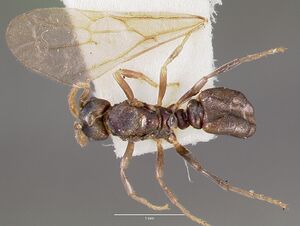 
| |
| Queen (alate/dealate). Specimen code casent0006097. Photographer April Nobile, uploaded by California Academy of Sciences. | Owned by CAS, San Francisco, CA, USA. |
   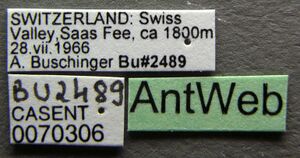
| |
| Queen (alate/dealate). Specimen code casent0070306. Photographer April Nobile, uploaded by California Academy of Sciences. | Owned by CAS, San Francisco, CA, USA. |
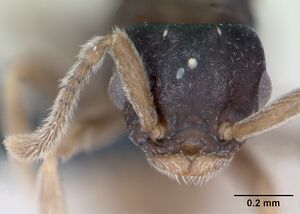   
| |
| Queen (alate/dealate). Specimen code casent0173077. Photographer April Nobile, uploaded by California Academy of Sciences. | Owned by CAS, San Francisco, CA, USA. |
Male
Images from AntWeb
   
| |
| Male (alate). Specimen code casent0010835. Photographer April Nobile, uploaded by California Academy of Sciences. | Owned by UCDC, Davis, CA, USA. |
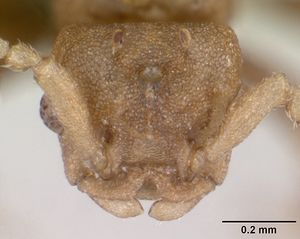   
| |
| Male (alate). Specimen code casent0070305. Photographer April Nobile, uploaded by California Academy of Sciences. | Owned by CAS, San Francisco, CA, USA. |
 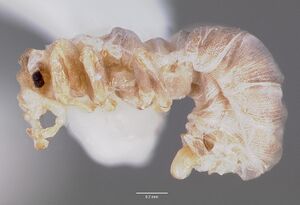  
| |
| Male (alate). Specimen code casent0003228. Photographer April Nobile, uploaded by California Academy of Sciences. | Owned by CAS, San Francisco, CA, USA. |
Nomenclature
The following information is derived from Barry Bolton's Online Catalogue of the Ants of the World.
- atratulum. Myrmica atratula Schenck, 1852: 91 (q.m.) GERMANY.
- [Also described as new by Schenck, 1853: 186.]
- Wheeler, W.M. 1909g: 182 (l.).
- Combination in Tetramorium: Mayr, 1855: 429.
- Combination in Anergates: Forel, 1874: 68 (see also p. 93).
- Combination in Tetramorium: Ward et al., 2014: 16.
- Senior synonym of friedlandi: Creighton, 1950a: 243.
- See also: Donisthorpe, 1915d: 89; Boven, 1977: 81; Wheeler, G.C. & Wheeler, J. 1955c: 128; Atanassov & Dlussky, 1992: 161.
- friedlandi. Anergates friedlandi Creighton, 1934: 193 (q.) U.S.A.
- Junior synonym of atratulum: Creighton, 1950a: 243.
Unless otherwise noted the text for the remainder of this section is reported from the publication that includes the original description.
Description
Worker
1 1/4 - 1 3/4 L. Sie ist der fuscula so ähnlich, daß man sie von den dunkelsten Varietäten dieser art kaum unterscheiden kann. In der Gestalt aller Theile und dem Größenverhältniß stimmt sie ganz damit überein. Die Farbe ist tief schwartz, der hinterleib sehr glänzend, der ganze Körper mit gelblichen Borstenhaaren besetzt, ebenso Fühler und Beine; die Ränder der Hinterleibsegmente schimmern rötlich. Oberkiefer, der untere Theil der Backen, zuweilen auch der unterste Theil des Kopfschildes, die Hinterseite des Kopfes mehr oder weniger, die Fühlergeißel und Tarsen braunroth; die Glieder der leßteren braun geringelt; der Schaft dunkelbraun, an der Spitze braunroth; Hüften, Schenkel und Schienen dunkelbraun, Spitze der Schienen braunroth. Die Sculptur, wie bei fuscula; nur sind die Streifen des Kopfes und des Thorax grober, schärfer und weiter von einander entfernt. Der Metathorax hat dieselbe Veränderlichkeit in seiner Sculptur, wie bei fuscula. Die Dornspitzen sind zahnartig, spitz, aufgerichtet: Die Knoten glatt oder schwach gerunzelt. Die Bindehaut zwischen den Hinterleibsegmenten ist rötlich und kommt bei dem Auseinanderdehnen der Ringe zum Vorschein, z. B. bei längerem Einweichen.
Queen
Creighton (1934), of the synonomized friedlandi - Length: 2.2 mm. (the gaster not expanded). Differing from the female of atratulum in the following characteristics: The single mucronate point with which the mandible is armed longer and stouter; the convex masticatory border of the mandible very feebly serrate (smooth in atratulum). Eyes nearly circular in outline and strongly convex with rather fine facets (oval and moderately convex with coarse facets in atratulum). Lateral ocelli small and so placed that they are hidden when the head is viewed from directly in front by the rectangular occipital crest on which they are borne (lateral ocelli larger and distinctly visible from the front in atratulum). Antennal scapes slightly and evenly curved outward, gradually increasing in thickness from base to apex and in repose surpassing the occipital border by an amount equal to the greatest thickness (in atratulum the scapes are almost straight, thickest at a point about three quarters of the distance to the apex and in repose surpassing the occipital border by an amount less than their greatest thickness). Seen from above the epaulet-like lateral portions of the pronotum are strongly concave, blunted behind and set off from the median portion of the pronotum by a rounded welt or ridge (in atratulum the lateral portions of the pronotum are only slightly concave, rather sharp behind and set off from the median portion of the pronotum by a sharp ridge). Scutum longer than in atratulum and with more overhang at the anterior edge. The posterior portion of the scutum is evenly depressed all the way across including the paraptera so that there is a sharp transition to the scutellum when the thorax is viewed in profile (in atratulum the depression of the scutum is median only, the paraptera not being depressed, so that there is a sort of a shallow trough formed on the dorsum of the thorax; however in profile the transition between the scutum and scutellum appears less abrupt because of the elevation of the paraptera above the level of the middle of the scutum). Scutellum narrower and much more convex than in atratulum. Epinotum seen from above with the lateral projections less prominent and more rounded than in atratulum. Seen from behind the broad longitudinal impression on the posterior face of the epinotum is broadly rounded above (narrower and rather pointed above in atratulum). Seen in profile the node of the petiole has a definite, short posterior face, a rounded and rather narrow summit and a long steeply sloping anterior face. Although both posterior anterior peduncles are short both are distinctly visible in profile and sharply set off from the node (in atratulum the node of the petiole is much bulkier with the dorsum broad and obtusely angular. The anterior and posterior peduncles are so short as to be virtually invisible when seen in profile). Postpetiole seen from above thinner from front to back than in atratulum with the anterior edge much less convex. The dorsum bears a shallow, median longitudinal sulcus (entire in atratulum). Abdomen with a deep median sulcus as in atratulum.
Sculpture very finely and evenly punctato-rugose except the very deeply notched clypeal border, the mandibles and the appendages which are shining. The sculpture is uniformly heavier than in atratulum, particularly on the posterior abdominal segments where it renders the surface definitely opaque (feebly shining in atratulum).
Color: head and thorax blackish brown, gaster a somewhat clearer brown, appendages dirty yellow. Wings hyaline, covered with numerous small hairs, the veins and stigma pale yellow.
References
- Adlerz, G. 1886. Myrmecologiska studier. II. Svenska myror och deras lefnadsförhållanden. Bihang till Kongliga Svenska Vetenskaps-Akademiens Handlingar. 11(18):1-329.
- Adlerz, G. 1908. Zwei Gynandromorphen von Anergates atratulus Schenck. Ark. Zool. 5(2 2: 1-6) PDF
- Atanassov, N.; Dlussky, G. M. 1992. Fauna of Bulgaria. Hymenoptera, Formicidae. Fauna Bûlg. 22: 1-310 (page 161, see also)
- Boven, J. K. A. van. 1977. De mierenfauna van België (Hymenoptera: Formicidae). Acta Zool. Pathol. Antverp. 67: 1-191 (page 81, see also)
- Buschinger, A. 2009. Social parasitism among ants: a review (Hymenoptera: Formicidae). Myrmecological News 12: 219-235.
- Buschinger, A., B. C. Schlick-Steiner, F. M. Steiner, and M. Sanetra. 2003. Anergates atratulus, eine ungewöhnlich seltene Parasiten-Ameise. Ameisenschutz Aktuell. 17:1-6.
- Collingwood, C. A. 1979. The Formicidae (Hymenoptera) of Fennoscandia and Denmark. Fauna Entomol. Scand. 8:1-174.
- Crawley, W. C. 1912. Anergates atratulus, Schenk., a British ant, and the acceptance of a queen by Tetramorium caespitum, L. Entomologist's Record and Journal of Variation. 24:218-219.
- Creighton, W. S. 1934. Descriptions of three new North American ants with certain ecological observations on previously described forms. Psyche (Camb.) 41: 185-200. (page 243, Senior synonym of freidlandi)
- Csősz, S., Báthori, F., Gallé, L., Lőrinczi, G., Maák, I., Tartally, A., Kovács, É., Somogyi, A.Á., Markó, B. 2021. The myrmecofauna (Hymenoptera: Formicidae) of Hungary: Survey of ant species with an annotated synonymic inventory. Insects 16;12(1):78 (doi:10.3390/insects12010078).
- Csosz, S., Marko, B., Galle, L. 2011. The myrmecofauna (Hymenoptera: Formicidae) of Hungary: an updated checklist. North-Western Journal of Zoology 7: 55-62.
- Czechowski, W., Radchenko, A., Czechowska, W. 2002. The ants (Hymenoptera, Formicidae) of Poland. MIZ PAS Warsaw.
- Dash, S.T. & Sanchez, L. 2009. New distribution record for the social parasitic ant Anergates atratulus (Schenck, 1852) (Hymenoptera: Formicidae): An IUCN red-listed species. Western North American Naturalist 69: 140-141.
- Dekoninck, W., Ignace, D., Vankerkhoven, F., Wegnez, P. 2012. Verspreidingsatlas van de mieren van België. Bulletin de la Société royale belge d’Entomologie 148: 95-186.
- Donisthorpe, H. 1915f. British ants, their life-history and classification. Plymouth: Brendon & Son Ltd., xv + 379 pp. (page 89, see also)
- Dubovikoff, D.A., Yusupov, Z.M. 2017. Family Formicidae - Ants. In Belokobylskij S. A. and A. S. Lelej: Annotated catalogue of the Hymenoptera of Russia. Proceedingss of the Zoological Institute of the Russian Academy of Sciences 6: 197-210.
- Fisher and Cover. 2007. Ants of North America. A guide to the Genera. University of California Press.
- Forel, A. 1874. Les fourmis de la Suisse. Systématique, notices anatomiques et physiologiques, architecture, distribution géographique, nouvelles expériences et observations de moeurs. Neue Denkschr. Allg. Schweiz. Ges. Gesammten Naturwiss. 26: 1-452 (page 68, Combination in Anergates)
- García, F., Cuesta-Segura, A.D., Espadaler, X. 2024. Myrmica babiensis sp. nov. (Hymenoptera: Formicidae), a new social parasite from the NW Iberian Peninsula. Annales Zoologici 74(1), 113-127 (doi:10.3161/00034541anz2024.74.1.006).
- Heinze, J., B. Lautenschläger, and A. Buschinger. 2007. Female-biased sex ratios and unusually potent males in the social parasite Anergates atratulus (Hymenoptera: Formicidae). Myrmecological News. 10:1-5 PDF.
- Ivanov, K. 2019. The ants of Ohio (Hymenoptera, Formicidae): an updated checklist. Journal of Hymenoptera Research 70: 65–87 (doi:10.3897@jhr.70.35207).
- Kiran, K., Karaman, C. 2020. Additions to the ant fauna of Turkey (Hymenoptera, Formicidae). Zoosystema 42(18), 285-329 (doi:10.5252/zoosystema2020v42a18).
- Kiran, K., Karaman, C., Heinze, J. 2021. First record of the inquiline ant Leptothorax kutteri Buschinger, 1965 from Turkey. Sociobiology 68, e7224 (doi:10.13102/sociobiology.v68i3.7224).
- Lapeva-Gjonova, A.; Kiran, K.; Aksoy V. 2012. Unusual ant hosts of the socially parasitic ant Anergates atratulus (Schenck, 1852) (Hymenoptera, Formicidae). Psyche doi:10.1155/2012/391525
- Mayr, G. 1855. Formicina austriaca. Beschreibung der bisher im österreichischen Kaiserstaate aufgefundenen Ameisen, nebst Hinzufügung jener in Deutschland, in der Schweiz und in Italien vorkommenden Arten. Verh. Zool.-Bot. Ver. Wien 5: 273-478 (page 429, Combination in Tetramorium)
- Moss, A.D., Swallow, J.G., Greene, M.J. 2022. Always under foot: Tetramorium immigrans (Hymenoptera: Formicidae), a review. Myrmecological News 32: 75-92 (doi:10.25849/MYRMECOL.NEWS_032:075).
- Purkart, A., Wagner, H.C., Goffová, K., Selnekovič, D., Holecová, M. 2022. Laboratory observations on Anergates atratulus (Schenck, 1852): mating behaviour, incorporation into host colonies, and competition with Strongylognathus testaceus (Schenck, 1852). Biologia (doi:10.1007/s11756-021-00901-y).
- Purkart, A., Marko, Š., Vanerková, V., Holecová, M. 2023. State of knowledge of the socially parasitic ant Anergates atratulus (Schenck, 1852) in Slovakia. Entomofauna carpathica 35(2): 53-66.
- Salata, S., van Delft, J.P.L., van Delft, J.J.C.W., Georgiadis, C., Borowiec, L. 2023. Tetramorium albenae Salata, van Delft & Borowiec n. sp. (Hymenoptera, Formicidae) – a new inquiline ant species from the Balkan Peninsula. The European Zoological Journal 90(1), 333–343 (doi:10.1080/24750263.2023.2198548).
- Sanetra, M., Güsten, R., Schulz, A. 1999. On the taxonomy and distribution of Italian Tetramorium species and their social parasites (Hymenoptera Formicidae). Memorie della Societa Entomologica Italiana 77: 317-357.
- Schenck, C. F. 1852. Beschreibung nassauischer Ameisenarten. Jahrb. Ver. Naturkd. Herzogthum Nassau Wiesb. 8: 1-149 (page 91, queen, male described)
- Schenck, C. F. 1853b. Die nassauischen Ameisen-Species. (Fortsetzung.). Stett. Entomol. Ztg. 14: 185-198 (page 186, also described as new)
- Schifani, E., Csősz, S., Viviano, R., Alicata, A. 2021. Ant diversity on the largest Mediterranean islands: on the presence or absence of 28 species in Sicily (Hymenoptera, Formicidae). Natural History Sciences 8, 55–70 (doi:10.4081/nhs.2021.532).
- Schifani, E., Nalini, E., Gentile, V., Alamanni, F., Ancona, C., Caria, M., Cillo, D., Bazzato, E. 2021. Ants of Sardinia: An updated checklist based on new faunistic, morphological and biogeographical notes. Redia 104, 21–35 (doi:10.19263/redia-104.21.03).
- Wagner, H.C., Arthofer, W., Seifert, B., Muster, C., Steiner, F.M. & Schlick-Steiner, B.C. 2017. Light at the end of the tunnel: Integrative taxonomy delimits cryptic species in the Tetramorium caespitum complex. Myrmecological News 25: 95-129.
- Ward, P.S., Brady, S.G., Fisher, B.L., Schultz, T.R. 2015. The evolution of myrmicine ants: phylogeny and biogeography of a hyperdiverse ant clade (Hymenoptera: Formicidae). Systematic Entomology 40: 61–81 (doi:10.1111/syen.12090).
- Wheeler, G. C.; Wheeler, J. 1955c. The ant larvae of the myrmicine tribe Solenopsidini. Am. Midl. Nat. 54: 119-141 (page 128, see also)
- Wheeler, W. M. 1908. Comparative ethology of the European and North American ants. J. Psychol. Neurol. 13:404-435, pl. III-IV.
- Wheeler, W. M. 1909g. Observations on some European ants. J. N. Y. Entomol. Soc. 17: 172-187 (page 182, larva described)
References based on Global Ant Biodiversity Informatics
- Agosti, D. and C.A. Collingwood. 1987. A provisional list of the Balkan ants (Hym. Formicidae) and a key to the worker caste. I. Synonymic list. Mitteilungen der Schweizerischen Entomologischen Gesellschaft, 60: 51-62
- Alvarado M., and L. Galle. 2000. Ant assemblages associated with lowland forests in the southern part of the great Hungarian plain. Acta Zoologica Academiae Scientarum Hungaricae 46(2): 79-102.
- AntArea. Accessed on February 5th 2014 at http://antarea.fr/fourmi/
- Antarea (at www.antarea.fr on June 11th 2017)
- ArtDatabanken Bugs (via GBIG)
- Asociacion Iberica de Mirmecologia. 2012. List of species collected during the Taxomara Tres Cantos 2012. Iberomyrmex 4: 17-18.
- Assing V. 1989. Die Ameisenfauna (Hym.: Formicidae) nordwestdeutscher Calluna-Heiden. Drosera 89: 49-62.
- Astric A., and H. Callot. 2006. Presence d'Anergates atratulus (Schenck, 1852) et Strongylognathus testaceus (Schenck, 1852) en Alsace. Bull. Soc. Ent. Mulhouse 62(2): 19-21.
- Baroni Urbani C., and C. A. Collingwood. 1976. A Numerical Analysis of the Distribution of British Formicidae (Hymenoptera, Aculeata). Verhandlungen der Naturforschenden Gesellschaft in Basel 85: 51-91.
- Baroni Urbani C., and C. A. Collingwood. 1977. The zoogeography of ants (Hymenoptera, Formicidae) in Northern Europe. Acta Zoologica Fennica 152: 1-34.
- Bernard F. 1967. Faune de l'Europe et du Bassin Méditerranéen. 3. Les fourmis (Hymenoptera Formicidae) d'Europe occidentale et septentrionale. Paris: Masson, 411 pp.
- Bernard, F. "Notes sur les fourmis de France. II. Peuplement des montagnes méridionales." Annales de la Société Entomologique de France 115 (1950): 1-36.
- Boer P. 2019. Species list of the Netherlands. Accessed on January 22 2019 at http://www.nlmieren.nl/websitepages/specieslist.html
- Boer P., W. Dekoninck, A. J. Van Loon, and F. Vankerkhoven. 2003. Lijst van mieren (Hymenoptera: Formicidae) van Belgie en Nederland, hun Nederlandse namen en hun voorkomen. Entomologische Berichten (Amsterdam) 63: 54-58.
- Boer P., W. Dekoninck, A. J. van Loon, and F. Vankerkhoven. 2003. Lijst van mieren (Hymenoptera: Formicidae) van Belgie en Nederland, hun Nederlandse namen en hun voorkomen. Entomologische Berichten 63(3): 54-57.
- Boer P., W. Dekoninck, A. J. van Loon, and F. Vankerkhoven. 2003. List of ants (Hymenoptera: Formicidae) of Belgium and The Netherlands, their status and Dutch vernacular names. Entomologische Berichten 63 (3): 54-58.
- Bolton B. 1976. The ant tribe Tetramoriini (Hymenoptera: Formicidae). Constituent genera, review of smaller genera and revision of Triglyphothrix Forel. Bulletin of the British Museum (Natural History). Entomology 34:281-379.
- Bonaric J. C. 1971. Contribution a l'etude systematique et ecologique des formicides du Bas-Languedoc. PhD thesis Universite des sciences et techniques du Languedoc, 175 pages.
- Bonaric J. C. 1971. Étude systématique et ecologique des fourmis de lHérault (suite). Ann. Soc. Hortic. Hist. Nat. Hérault 111: 119-126.
- Borowiec L. 2014. Catalogue of ants of Europe, the Mediterranean Basin and adjacent regions (Hymenoptera: Formicidae). Genus (Wroclaw) 25(1-2): 1-340.
- Borowiec L., and S. Salata. 2012. Ants of Greece - Checklist, comments and new faunistic data (Hymenoptera: Formicidae). Genus 23(4): 461-563.
- Bracko G., K. Kiran, C. Karaman, S. Salata, and L. Borowiec. 2016. Survey of the ants (Hymenoptera: Formicidae) of the Greek Thrace. Biodiversity Data Journal 4: e7945. doi: 10.3897/BDJ.4.e7945
- Buschinger A. 1985. New records of rare parasitic ants (Hym., Form.) in the French Alps. Insectes Sociaux 32(3): 321-324.
- Buschinger A. 1999. Bemerkenswerte ameisenfunde aus Sudtirol (Hymenoptera: Formicidae). Myrmecologische Nachrichten 3: 1-8.
- Buschinger, A., W. Ehrhardt, and K. Fischer. "Doronomyrmex pacis, Epimyrma stumperi und E. goesswaldi (Hym., Formicidae) neu für Frankreich." Insectes Sociaux 28 (1981): 67-70.
- Casevitz-Weulersse J., and C. Galkowski. 2009. Liste actualisee des Fourmis de France (Hymenoptera, Formicidae). Bull. Soc. Entomol. Fr. 114: 475-510.
- Casevitz-Weulersse J., and M. Prost. 1991. Fourmis de la Côte-d'Or présentes dans les collections du Muséum d'Histoire Naturelle de Dijon. Bulletin Scientifique de Bourgogne 44: 53-72.
- Collingwood C. A. 1971. A synopsis of the Formicidae of north Europe. Entomologist 104: 150-176
- Collingwood, C. A. 1958b. A key to the species of ants (Hymenoptera, Formicidae) found in Britain. Trans. Soc. Br. Entomol. 13: 69-96
- Collingwood, C. A. 1964. The Identification of British Ants (Hym. Formicidae). Transactions of the Society for British Entomology. 16:93-121.
- Collingwood, C. A. "The Formicidae (Hymenoptera) of Fennoscandia and Denmark." Fauna Entomologica Scandinavica 8 (1979): 1-174.
- Csősz S., B. Markó, and L. Gallé. 2011. The myrmecofauna (Hymenoptera: Formicidae) of Hungary: an updated checklist. North-Western Journal of Zoology 7: 55-62.
- Czechowski W., A. Radchenko, W. Czechowska and K. Vepsäläinen. 2012. The ants of Poland with reference to the myrmecofauna of Europe. Fauna Poloniae 4. Warsaw: Natura Optima Dux Foundation, 1-496 pp
- Della Santa E. 1995. Fourmis de Provence. Faune Provence 16: 5-37.
- Du Merle P. 1978. Les peuplements de fourmis et les peuplements d'acridiens du Mont Ventoux II. - Les peuplements de fourmis. Terre Vie 32(1): 161-218.
- Dubovikoff D. A., and Z. M. Yusupov. 2018. Family Formicidae - Ants. In Belokobylskij S. A. and A. S. Lelej: Annotated catalogue of the Hymenoptera of Russia. Proceedingss of the Zoological Institute of the Russian Academy of Sciences 6: 197-210.
- Else G., B. Bolton, and G. Broad. 2016. Checklist of British and Irish Hymenoptera - aculeates (Apoidea, Chrysidoidea and Vespoidea). Biodiversity Data Journal 4: e8050. doi: 10.3897/BDJ.4.e8050
- Emery C. 1916. Fauna entomologica italiana. I. Hymenoptera.-Formicidae. Bullettino della Società Entomologica Italiana 47: 79-275.
- Espadaler X., X. Roig, K. Gómez, and F. García. 2011. Formigues de les Planes de Son i mata de València (Hymenoptera, Formicidae) Treballs de la Institució Catalana d'Història Natural 16: 609-627.
- Galkowski C. 2008. Quelques fourmis nouvelles ou intéressantes pour la faune de France (Hymenoptera, Formicidae). Bulletin de la Société Linnéenne de Bordeaux, 143, N.S. 36, 4 : 423-433.
- Galkowski C. 2013. Nouvelles données sur la répartition de Strongylognathus huberi Forel, 1874 (Hymenoptera, Formicidae) en France. Bulletin de la Société Linnéenne de Bordeaux (n.s.) 41: 167-174.
- Galkowski C., and C. Foin. 2013. Nouvelles données sur la répartition de Strongylognathus huberi Forel, 1874 (Hymenoptera, Formicidae) en France. Bulletin de la Société Linnéenne de Bordeaux (n.s.) 41: 167-174.
- Gallé L., B. Markó, K. Kiss, E. Kovács, H. Dürgő, K. Kőváry, and S. Csősz. 2005. Ant fauna of Tisza river basin (Hymenoptera: Formicidae). In: Gallé, L. (szerk.): Vegetation and Fauna of Tisza River Basin I. Tiscia Monograph Series 7; Szeged, pp. 149-197.
- Garcia Garcia F. 2010. First records from Galicia of Anergates atratulus (Schek, 1852) (Hymenoptera, Formicidae). Iberomyrmex 2: 11-14.
- Garcia Garcia F., and A. D. Cuesta-Esgura. 2017. First catalogue of the ants of Burgos province, Spain (Hymenoptera: Formicidae). Boletín de la Sociedad Entomológica Aragonesa 60: 245–258.
- Holgersen H. 1944. The ants of Norway (Hymenoptera, Formicidae). Nytt Magasin for Naturvidenskapene 84: 165-203.
- Kanizsai O., R. Gallé, and L. Gallé. 2009. Perception of spatial patchiness by ant assemblages (Hymenoptera: Formicidae). Tiscia 37: 3-7.
- Kiran K., and C. Karaman. 2012. First annotated checklist of the ant fauna of Turkey (Hymenoptera: Formicidae). Zootaxa 3548: 1-38.
- Lomnicki J. 1928. Spis mrówek Lwowa i okolicy. Ksiegi Pamiatkowej (Lecia Gimn. IV Jana Dlugosza Lwowie) 50: 1-10.
- Majzlan O., and P. Devan. 2009. Selected insect groups (Hymenoptera, Neuroptera, Mecoptera, Raphidioptera) of the Rokoš Massif (Strážovské vrchy Mts.). Rosalia (Nitra), 20, p. 63–70.
- Markó B., B. Sipos, S. Csősz, K. Kiss, I. Boros, and L. Gallé. 2006. A comprehensive list of the ants of Romania (Hymenoptera: Formicidae). Myrmecologische Nachrichten 9: 65-76.
- Neumeyer R., and B. Seifert. 2005. Commented check list of free living ant (Hymenoptera: Formicidae) species of Switzerland. Bulletin de la Societe Entomologique Suisse 78: 1-17.
- Nielsen M. G. 2011. A check list of Danish ants and proposed common names. Ent. Meddr. 79: 13-18.
- Odegaard F., K. M. Olsen, A. Staverlokk, and J. O. Gjershaug. 2015. Towards a new era for the knowledge of ants (Hymenoptera, Formicidae) in Norway? Nine species new to the country. Nowegian Journal of Entomology 62: 80–99.
- Paraschivescu D. 1978. Elemente balcanice in mirmecofauna R. S. Romania. Nymphaea 6: 463- 474.
- Saaristo M. I. 1995. Distribution maps of the outdoor myrmicid ants (Hymenoptera, Formicidae) of Finland, with notes on their taxonomy and ecology. Entomol. Fennica 6: 153-162.
- Sanetra M., R. Güsten, and A. Schulz. 1999. On the taxonomy and distribution of Italian Tetramorium species and their social parasites (Hymenoptera Formicidae). Memorie della Societa Entomologica Italiana 77: 317-357.
- Saure C. 2005. Rote Liste und Gesamtartenliste der Bienen und Wespen (Hymenoptera part.) von Berlin mit Angaben zu den Ameisen. In: DER LANDESBEAUFTRAGTE FÜR NATURSCHUTZ UND LANDSCHAFTSPFLEGE / SENATSVERWALTUNG FÜR STADTENTWICKLUNG (Hrsg.): Rote Listen der gefährdeten Pflanzen und Tiere von Berlin. CD-ROM.
- Schar S., G Talavera, X. Espadaler, J. D. Rana, A. A. Andersen, S. P. Cover, and R. Vila. 2018. Do Holarctic ant species exist? Trans-Beringian dispersal and homoplasy in the Formicidae. Journal of Biogeography 00: 1-12.
- Schulz, A., and M. Sanetra. "Notes on the socially parasitic ants of Turkey and the synonymy of Epimyrma (Hymenoptera: Formcidae)." Entomofauna, Zeitschrift für Entomologie 23 (14) (2002): 157-172.
- Scupola A. 1994. Contributo alla mirmecofauna Italiana (Hymenoptera, Formicidae). Boll. Mus. Civ. St. Nat. Verona 18: 133-136.
- Seifert B. 1994. Die freilebenden Ameisenarten Deutschlands (Hymenoptera: Formicidae) und Angaben zu deren Taxonomie und Verbreitung. Abhandlungen und Berichte des Naturkundemuseums Görlitz 67(3): 1-44.
- Seifert B. 1998. Rote Liste der Ameisen. - in: M. Binot, R. Bless, P. Boye, H. Gruttke und P. Pretscher: Rote Liste gefährdeter Tiere Deutschlands. Bonn-Bad Godesberg 1998: 130-133.
- Sonnenburg H. 2005. Die Ameisenfauna (Hymenoptera: Formicidae) Niedersachsens und Bremens. Braunschweiger Naturkundliche Schriften 7: 377-441.
- Steiner F. M., S. Schödl, and B. C. Schlick-Steiner. 2002. Liste der Ameisen Österreichs (Hymenoptera: Formicidae), Stand Oktober 2002. Beiträge zur Entomofaunistik 3: 17-25.
- Stumper R. 1953. Etudes myrmecologiques. XI. Fourmis luxembourgeoises. Bulletin Soc. Nat. luxemb. 57: 122-135.
- Szujecki A., J. Szyszko, S. Mazur, and S. Perlinski. 1978. A succession of the ants (Formicidae) on afforested arable land and forest soils. Memorabilia Zoologica 29: 183-189.
- Tinaut A. 2016. Ants of the Tejeda, Almijara and Alhama Mountains Natural Park (Andalusia, Spain) (Hymenoptera, Formicidae). Boln. Asoc. esp. Ent., 40 (1-2): 125-159.
- Wegnez P., and M. Fichaux. 2015. Liste actualisee des especes de fourmis repertoriees au Grand-Duche de Luxembourg (Hymenoptera: Formicidae). Bulletin de la Société royale belge d’Entomologie 151: 150-165
- Wheeler W. M. 1909. Observations on some European ants. Journal of the New York Entomological Society 17: 172-187.
- Wheeler W. M. 1914. Gynandromorphous ants described during the decade 1903-1913. American Naturalist 48: 49-56.
- Pages using DynamicPageList3 parser function
- IUCN Red List vulnerable species
- Ant Associate
- Host of Tetramorium caespitum
- Host of Tetramorium impurum
- Host of Tetramorium diomedeum
- Host of Tetramorium moravicum
- Host of Tetramorium chefketi
- Host of Tetramorium immigrans
- Workerless Inquiline
- Secretly invasive
- Photo Gallery
- North temperate
- FlightMonth
- Species
- Extant species
- Formicidae
- Myrmicinae
- Crematogastrini
- Tetramorium
- Tetramorium atratulum
- Myrmicinae species
- Crematogastrini species
- Tetramorium species
- IUCN Red List
- Ssr








